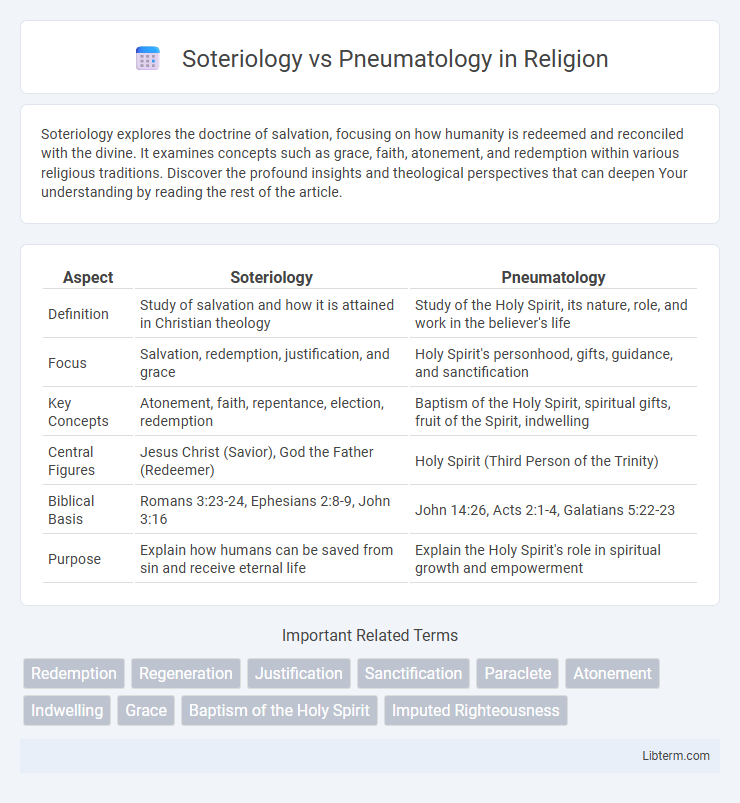Soteriology explores the doctrine of salvation, focusing on how humanity is redeemed and reconciled with the divine. It examines concepts such as grace, faith, atonement, and redemption within various religious traditions. Discover the profound insights and theological perspectives that can deepen Your understanding by reading the rest of the article.
Table of Comparison
| Aspect | Soteriology | Pneumatology |
|---|---|---|
| Definition | Study of salvation and how it is attained in Christian theology | Study of the Holy Spirit, its nature, role, and work in the believer's life |
| Focus | Salvation, redemption, justification, and grace | Holy Spirit's personhood, gifts, guidance, and sanctification |
| Key Concepts | Atonement, faith, repentance, election, redemption | Baptism of the Holy Spirit, spiritual gifts, fruit of the Spirit, indwelling |
| Central Figures | Jesus Christ (Savior), God the Father (Redeemer) | Holy Spirit (Third Person of the Trinity) |
| Biblical Basis | Romans 3:23-24, Ephesians 2:8-9, John 3:16 | John 14:26, Acts 2:1-4, Galatians 5:22-23 |
| Purpose | Explain how humans can be saved from sin and receive eternal life | Explain the Holy Spirit's role in spiritual growth and empowerment |
Defining Soteriology and Pneumatology
Soteriology is the theological study concerned with the doctrines of salvation, exploring how humanity is redeemed through divine intervention, grace, and faith. Pneumatology focuses on the study of the Holy Spirit, examining its nature, role, and operations within the Christian faith. Understanding both fields is essential for grasping the comprehensive framework of Christian doctrine regarding salvation and spiritual influence.
Historical Development of Soteriology
The historical development of soteriology traces the evolving understanding of salvation from early Christian thought, emphasizing Christ's redemptive work and its implications for humanity's reconciliation with God. Key theological milestones include Augustine's doctrines on original sin and grace, the Reformation's emphasis on justification by faith, and contemporary debates surrounding universalism and liberation theology. This progression highlights the dynamic interplay between biblical interpretation, cultural context, and doctrinal formulations in shaping soteriological concepts.
Historical Evolution of Pneumatology
The historical evolution of Pneumatology traces its roots to early Christian theology, where the Holy Spirit's role was initially intertwined with Christology and Trinitarian doctrines. Over centuries, theologians like Augustine and later the Reformers expanded Pneumatology to emphasize the Spirit's activity in salvation, sanctification, and church life, distinguishing it from Soteriology's primary focus on the doctrine of salvation through Christ. The development of Pentecostal and Charismatic movements further shaped modern Pneumatology by highlighting the experiential and dynamic aspects of the Spirit's presence and gifts within Christian communities.
Key Doctrines in Soteriology
Soteriology centers on key doctrines such as justification, sanctification, redemption, and atonement, emphasizing how salvation is achieved and applied to believers through Jesus Christ. It explores the role of faith, grace, and the work of Christ in reconciling humanity to God. In contrast, Pneumatology studies the person and work of the Holy Spirit, examining spiritual gifts, regeneration, and sanctifying power within the believer's life.
Central Themes in Pneumatology
Pneumatology centers on the study of the Holy Spirit, emphasizing themes such as spiritual gifts, sanctification, and divine guidance. It explores the Spirit's role in empowering believers for service, fostering spiritual growth, and facilitating communion with God. This contrasts with Soteriology, which focuses on the doctrine of salvation and the work of Christ in human redemption.
Soteriology: Salvation and Human Destiny
Soteriology explores the theological doctrines of salvation, emphasizing humanity's redemption through divine grace and the transformative role of faith in securing eternal life. It examines the mechanisms by which salvation is attained, including justification, sanctification, and reconciliation with God, highlighting human destiny as one aligned with divine purpose and eternal communion. In contrast, Pneumatology centers on the study of the Holy Spirit's nature and activity, delineating its influence in guiding believers and empowering spiritual growth.
Pneumatology: The Work of the Holy Spirit
Pneumatology explores the work of the Holy Spirit in guiding, empowering, and sanctifying believers, emphasizing the Spirit's role in salvation and spiritual growth. It highlights the Holy Spirit's involvement in inspiring scripture, distributing spiritual gifts, and fostering divine communion within the church. This discipline contrasts with soteriology, which focuses primarily on the doctrine of salvation itself rather than the ongoing, dynamic influence of the Holy Spirit in the believer's life.
Comparative Analysis: Salvation and the Spirit
Soteriology explores the doctrine of salvation, emphasizing Christ's redemptive work and humans' reconciliation with God, while Pneumatology examines the Holy Spirit's role in empowering believers, guiding faith, and sanctification. Salvation in Soteriology centers on justification, atonement, and eternal life, whereas Pneumatology focuses on the Spirit's work in regeneration, spiritual gifts, and ongoing transformation. Comparative analysis reveals that both disciplines intersect in the Spirit's involvement in applying salvation benefits to the believer, highlighting a dynamic relationship between divine grace and spiritual empowerment.
Intersections between Soteriology and Pneumatology
Soteriology and Pneumatology intersect primarily through the role of the Holy Spirit in salvation, where the Spirit facilitates regeneration, sanctification, and assurance of faith. The Holy Spirit's work in illuminating Scripture and empowering believers for holy living directly impacts soteriological doctrines concerning grace, faith, and redemption. Understanding the dynamic between the Spirit's activity and the believer's salvation experience is crucial for a comprehensive theological framework integrating both disciplines.
Contemporary Debates: Soteriology vs Pneumatology
Contemporary debates on Soteriology vs Pneumatology emphasize the interplay between salvation doctrines and the work of the Holy Spirit, highlighting divergent views on divine grace and human response. Scholars analyze how Pneumatology shapes understandings of sanctification, spiritual gifts, and regeneration within the soteriological framework. Recent discussions also explore pneumatological implications for ecclesiology and eschatology, reflecting evolving theological perspectives on salvation's process and experience.
Soteriology Infographic

 libterm.com
libterm.com